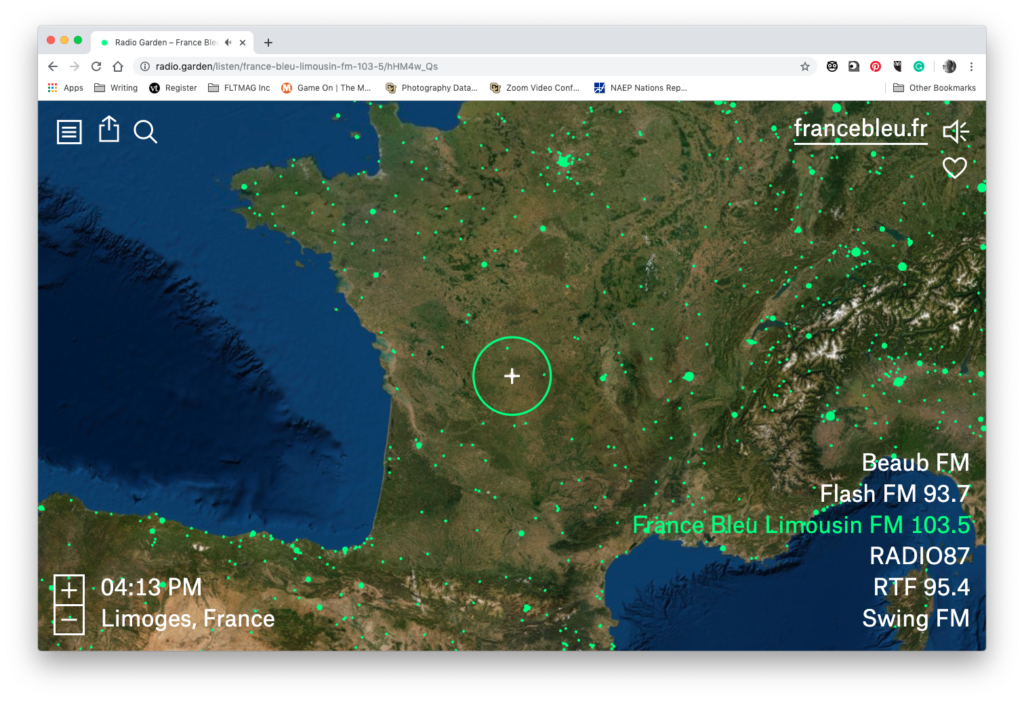Teaching World Languages with Music
 By Kristin M Marena, Spanish Teacher at Ringgold High School, PA.
By Kristin M Marena, Spanish Teacher at Ringgold High School, PA.
DOI: https://www.doi.org/10.69732/VXMY8446
“Music is life, that’s why our hearts have beats.” Cecily Morgan.
This quote expresses how much music is part of the human race and beats within us. Music transcends humanity and cultures. It communicates the diversity of the world in many forms, incorporating various styles, rhythms, instruments, lyrics, dance, histories, and the environment. No matter what your race, background, ethnicity, or socio-economic status may be, there is undoubtedly music in your life, and the music you like is part of who you are. From a language teacher’s perspective, much can be done in a language course with music. From teaching the language to history and culture, music is a perfect medium for language learning.
In this article, I will discuss some of the research behind music use in the language classroom and how to make music a part of your language program.
The Benefits of Music for Language Learning
“I think music in itself is healing, it’s an explosive expression of humanity, it’s something we are all touched by. No matter what culture we’re from, everyone loves music.” Billy Joel
Music has a healing effect. It reduces anxiety, increases focus (for some), sparks memory and motivation, and connects to our emotions. We know that a feeling of nervousness and apprehension may hinder student performance in a language class. In her article on Music in The Foreign Language Classroom, Degrave mentions several studies that concluded that teaching with songs reduces stress, especially for students with particularly high anxiety (Degrave, 2019).
According to Degrave, who reviewed the literature on this topic, using music in the foreign language classroom was also found to help with the acquisition of grammar, pronunciation, vocabulary and listening comprehension. She discusses the “Mozart Effect” and proposes that the use of music in the background can enhance language performance (for more information see, Suggestopedia Methodology, Lozanov, 1978). Degrave gives the example of a study in which students were given a multiple-choice vocabulary test after hearing a story. The study showed that students who heard a sung story performed better on the test than those who just hear the spoken story. The study used classical music in order to relax students’ state of mind and make the brain more receptive to learning. Even though the study concentrated on the use of classical music, Degrave also found that the use of instrumental music, in general, has the same effect.
I have often used music as a timer for students to complete their warm-up activity at the beginning of class or in the background while students are working on an assessment. I have observed that students are more focused on their work and exhibit more on-task behaviors when I use music. We all had the experience of singing along to a song, although we never intentionally tried to memorize the lyrics. When words are put to music, they tend to stick in our minds much more than spoken words. Using songs to teach vocabulary, grammatical structures, pronunciation, and culture also prove to be a motivating factor.
In her 2011 Language Educator article, Patricia Koning recounts the experience of author Susana Zaraysky with Portuguese: “I was listening to Portuguese radio stations every day while driving to and from work. Without even realizing it, I was picking up vocabulary, grammatical structures, and pronunciation”. In 2009, she wrote about her experiences in a book, Language is Music, in which she compiled a collection of tips on using media, such as music, to learn a foreign language. She has since presented her ideas to the U.S. Department of State, and universities such as Stanford and UC Berkeley.
Finally, Dr. Joanne Loewy, Director of the Louis Armstrong Center for Music & Medicine has conducted extensive research on music therapy. She has found that learning both music and language share similar cognitive processes. In her theory, The Musical Stages of Speech (1995), she proposes that language learning should be considered not in a cognitive context but a musical one.
Music and CI

For teachers who use a Comprehensible Input approach to language instruction, stories play a significant part in their teaching. Señor Wooly (James Woolridge) has successfully exploited the advantages of music and integrated it with CI on his website.
I have visited Sr. Wooly’s website in order to view his videos and I recently joined his Teachers Facebook page to see what teachers who use his materials are saying about it.
What I have seen from the Sr. Wooly Teacher Facebook page is that most teachers who use the resources available from Sr. Wooly recommend integrating them with the SOMOS curriculum created by Martina Bex, author of The Comprehensible Classroom. All in all, Sr. Wooly seems to integrate the advantages of music with the use of CI to maximize student engagement and learning.
There are two types of subscriptions for Sr. Wooly, Basic and Pro. Basic will get you access to all his videos and it costs $45.00/year. Pro ($85) gets you access to his videos, teaching resources, and the ability to create student accounts. To learn more about how Sr. Wooly rose to fame, read Jim Woolridge interview by Adrienne Gonzales (FLTMAG, 2016).
Without a subscription, you can view some video samples and of the ones I’ve seen, his videos are fun, silly, catchy, and quite comprehensible. Although they are not authentic, they are true “earworms”. Sarah Breckley, CI Spanish teacher and blogger, shared that parents report that students sing these songs even when they’re not at school. She also highlights just how diversely the Wooly stories can be utilized: “Wooly’s stories can be used to facilitate circling, story-asking, Socratic seminars, TPRS Movie Talks, crafts, Picture Talks, story sequencing, TPR, guided and embedding reading, PQA, comprehension games …and the best part is, SenorWooly.com has all kinds of readymade options: pages and pages of printable activities, embedded readings, lyrics, video games and online activities that can be completed on a mobile phone or a computer.”
In one of her blog posts, Breckley makes a case as to why these resources should be part of your class. She discusses several advantages to using the musical-CI resources available on the Sr. Wooly site. First of all, “all of his videos“, as she explains, “are comprehensible stories.” As we know from Krashen, comprehensible input is crucial for language acquisition (Krashen, 2017). Breckley continues to explain that the videos “mix CI stories, with visual input and musical accompaniment.” “The stories are compelling“, she says, “both visually and contextually.” Breckley also notes, “Wooly’s videos are so compelling that my students naturally maintain engagement.”
More Ideas and Resources on Teaching with Music

If you’re looking for a way to integrate more authentic music/songs into your language classroom, Allison Weinhold’s blog, Mis Clases Locas, is a comprehensive resource. Weinhold shares a plethora of ideas on how to integrate music into your language curriculum, including using music for brain breaks, using music as a warm-up activity, integrating it as a weekly ritual (música miérocoles) or making it the heart of your lesson. She suggests using music videos as Movie Talks, have students listen to the audio and make predictions, analyzing the lyrics, draw what the song is about, putting lyrics in order, tallying the number of times they hear a word or phrase, writing a review as a critic, and investigating the artist, genre, or song.
Another popular idea is March Madness, an idea adapted from the popular brackets that many engage in during College basketball March Madness playoffs. Weinhold proposes several ideas, from focusing on Hispanic Heritage, particular music genres, countries, women artists, and even time-periods. In a Facebook live event held on July 25, 2018, Weinhold shared her favorite resources, including Zachary Jones, who hosts a website dedicated to teaching Spanish with music, Radio Garden, a site where you can access radio stations from around the world, and techniques such as incorporating dance and karaoke.


I have tried incorporating dance with various levels of success in my own classes. As Weinhold mentions, you need to start with an already outgoing group of students. This has also been my experience. In truth, dance can be quite contagious, and once you get them started, the challenge is getting them to stop.

I happened upon a karaoke app called SLIONS, available through the Google Play Store, made especially for language learning. The app includes a feedback feature. I downloaded the app and played with it to assess it from the perspective of a language teacher.
First of all, I feel the app has a lot of potential but needs improvements to become a viable resource for educators and learners alike. Currently, the app is only available for those learning English or Chinese. It would be nice to see it available in more languages. There is a wide range of songs available, including nursery rhymes, traditional songs (like Christmas carols for example) and pop music. I chose to experience the app as a novice Chinese learner. First, it would be helpful for the app to include background information for each song they feature. I found it hard to connect with songs without knowing anything about them.
Secondly, I wish there were an option to slow down the playback speed of the songs so that students could try and pronounce the lyrics before attempting to sing it karaoke-style. The songs went at their natural speed and it was difficult to follow along. Attempting to pronounce, read, and comprehend simultaneously is challenging.
Finally, the lyrics were shown in pinyin and English. This was overwhelming to me as a novice learner. Some scaffolding, such a warm-up activity where the words are presented would be a useful feature.
This type of learning can be fun, but probably best reserved for the more outgoing learner. I was embarrassed to try singing and I was sitting alone in my living room!
When I first started teaching, I thought my high schoolers would be “too cool for school” and that they wouldn’t enjoy learning with music. Finally, one year I decided to take a chance and started incorporating songs from our textbook. The songs were designed to help students memorize vocabulary and grammar. What I found was that, yes, at first it was hard to get them to sing, but as the year progressed, students started to notice how much it contributed to their learning. They began asking what song we would be singing next and often asked to revisit previous songs, just for fun.
Conclusion
I recently started a quarterly speaking project where students chose an authentic song from a list I provided and learned a verse from the song. Students were excited about the music, downloading it onto their phones, singing it in the halls and during class. I took a group on a field trip to paint sugar skulls for the Day of the Dead and the instructor put on a Latino Pandora station for us to listen to as we painted. A song that the students knew from their speaking projects came on and they all started to sing along with absolutely no coaxing from me. It gave me that warm fuzzy feeling inside! As an educator and as someone who has personally used music in my acquisition of a second language, I know first hand the value that music has. If you haven’t already, I would highly recommend that you start using it as part of your lessons.
If you currently use or have used music in your language classroom, please share your ideas and experiences with me.
References:
Breckley, S. (2018, August 25). The Case for SeñorWooly.com. Retrieved from http://sarahbreckley.com/a-case-for-senorwooly-com
Degrave, Pauline. (2019). Music in the Foreign Language Classroom: How and Why? Journal of Language Teaching and Research. 10. 412. 10.17507/jltr.1003.02.
Leowy, J.The Musical Stages of Speech: A Developmental Model of Pre-Verbal Sound Making, Music Therapy, Volume 13, Issue 1, 1995, pgs 47–73
Koning, Patricia (2011). Language Can Be Music to Students’ Ears. The Language Educator, February 2011.
Krashen,S. The Case for Comprehensible Input, Language Magazine, July 2017.
Weinhold, A. (2017, February 19) March Music Madness in Spanish Class. Retrieved from https://misclaseslocas.blogspot.com/2018/02/mania-musical-de-mujeres-march-music.html
Weinhold, A. (2017, May 17) Using Señor Wooly in Spanish Class. https://misclaseslocas.blogspot.com/2017/05/using-sr-wooly-in-spanish-class.html
Weinhold, A (2017, June 14). What to do with a Song in Spanish Class. Retrieved from https://misclaseslocas.blogspot.com/2017/06/what-to-do-with-song-in-spanish-class.html


Amazing post! Music is a great way for language learning. Thanks for sharing.